
July 2020 |
|
|
 |
|
 Print Print
 Email EmailGo to www.ibew.org |
||
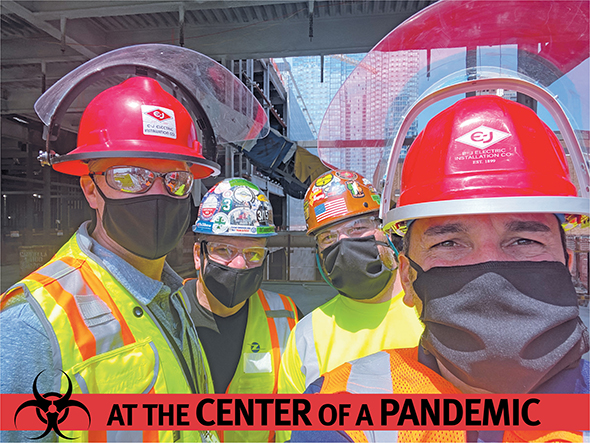 |
||
CRISES ARE A CALLING for the brothers and sisters of New York City Local 3. They were on the front lines when the towers fell. When Hurricane Sandy wreaked destruction. When other states and nations have cried out for help after storms and earthquakes. Nothing prepared them for COVID-19. By the end of March, the world's eyes had shifted from hotspots in Asia and Europe to the pandemic's new center: their hometown. "There's nothing that's comparable," Business Manager Chris Erikson said nearly three months into a catastrophe he couldn't have fathomed. "Nothing." Not even the unspeakable tragedy of 9/11, when Local 3 members ran toward the pile to aid rescue and recovery, then spent weeks in the toxic air of Ground Zero, rewiring Lower Manhattan. Not even the economic crash of 2008 that put 3,000 of Erikson's members out of work for a year. Splice those nightmares and you get COVID-19. Sick and dying patients spilling out of emergency rooms. Hundreds of thousands of New Yorkers jobless. A noisy, crowded, manic metropolis silenced, vacant. No one has been left unscathed. Like the city at large, IBEW members have experienced illness and death, layoffs and furloughs, fear that their jobs will be next, fear they'll be exposed to the virus, fear they'll infect their families. They've had to make hard decisions affecting their lives and livelihoods, just as billions of others around the world have had to do. But as always, they've risen to the occasion. They've built temporary hospitals and kept essential jobsites running. They've done the agonizing work of powering mobile morgues. They've given generously to charities, staffed food pantries and even helped get urgently needed protective gear to area hospitals. "We need you to lead by example," Erikson, a third-generation Local 3 leader and chairman of the IBEW's Executive Council, told members in a video message in early April. He never doubted they would. |
|
|
BY THE END OF MAY, more than 80 members of Local 3 had been hospitalized with COVID-19. Thirteen active members and 19 retirees had died. Sean McDonald was one of the survivors, but only after a frightening 11-day hospital stay. The virus was still creeping into the city when he started coughing. Seasonal allergies, he figured. He was a healthy 44-year-old looking forward to a week's vacation as he left his jobsite across from Grand Central Station on Friday, March 13. By Sunday, he'd quarantined himself in an upstairs room in his Nassau County home, apart from his wife, a pediatric nurse, and their four children. Five days later he was in the hospital. Isolated, he prayed his family wasn't infected, prayed that he wouldn't need a ventilator. "That was going through my head most of the time," said McDonald, a journeyman wireman and drummer in Local 3's Sword of Light pipe band. If his oxygen levels didn't improve, he knew the lightweight nasal cannula sending air through his nostrils wouldn't be enough. A machine would have to breathe for him through a tube in his windpipe. He'd be sedated, unable to talk or eat. His odds of recovery would drop dramatically. "What do I have to do to prevent that?" McDonald asked his medical team — nurses who were covered head to toe in protective gear; doctors who mainly checked on him by phone. They gave him a plastic device for breathing exercises. "You blow in, you blow out, you suck in as hard as you can. It's a little plastic device. I would do it all the time." |
|
|
LEN COPICOTTO didn't get ill. But he was shrouded by risk. He was one year into a survey contract in March, testing and tracing every circuit and outlet at a Queens hospital to ensure that no critical equipment would fail during planned renovations. "There are kiosks around the hospital with masks, Purell, Kleenex," said the Local 3 journeyman, who is carrying on the legacy of his father and grandfather. "For a year, I never saw anybody touch them." In the blink of an eye, the kiosks were busy. Anxiety was palpable. The hospital had gone from signage asking visitors if they'd been in China recently to converting wings into triage units and filling one floor after another with COVID-19 patients. Copicotto dove into science journals, educating himself about the disease without a media filter. Understanding what was coming was one thing. Arriving at work to find a mobile refrigeration unit in the hospital's parking lot was another. "It was one of those wake-up calls. We could see it from the window of our shanty. I said, 'Oh my God, guys, I hope you know what's parked right next to us right now. This is going to get bad.'" |
|
|
THE SIGNS stalked Erin Sullivan as she crossed the Hudson River en route to renovation work at a high-rise law firm near Rockefeller Center. "I'd had a cough and a headache for several days and I kept seeing these blinking signs on the Tappan Zee Bridge: 'Stay at Home, Stay at Home,'" said Sullivan, a journeyman wireworker and the local's mentoring director. "It was a really tough decision because we are so conditioned to show up and work," she said. "If we don't show up, we don't get paid, so a lot of us show up even we don't feel all that good. It's the norm." But there was nothing normal about COVID-19. "It was scary because nobody knew what was going on," Sullivan said. "And people at this point were starting to die. I knew someone who'd been healthy who had passed away in three days. He was 52, just like me." By that day, March 19, the city had recorded nearly 4,000 infections, double the day before. Concerned for her coworkers as much as herself, Sullivan called her foreman and headed home. Four days later, cases had tripled and her jobsite shut down.
|
|
|
|
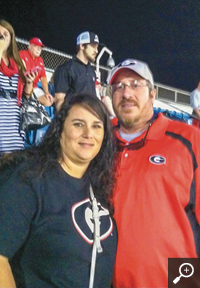 Ernie and Melissa Miller, pictured before COVID-19, contracted on the IBEW's largest jobsite, upended their lives. |
|
IN HIS MISSION to protect lives and jobs, Erikson is rethinking everything. No detail is too small. He has 30,000 members to consider, 300 employees, and his union's bottom line. Some 6,300 members were still laid off at the end of May, roughly 65% of the construction division. If the governor hadn't deemed many projects "essential," the pain would have been even greater. Erikson had to lay off about half the local's clerical workers and said he and all officers and business agents have taken pay cuts. A skeleton staff at headquarters and others at home kept Local 3 functioning as the virus paralyzed the city at large. "I'm proud to say that not one retiree missed a pension check or annuity check through any of this," he said. He is weighing the safest ways to revive the office and reopen the union hall — a gathering place as central to many Local 3 members as a parish church. "We're going to try to limit the interaction as much as we can," Erikson said. "We've got to figure out how to work differently, how to have the least amount of person-to-person contact but not lose the sense that this is your union, that we work for you." He can hear the voice of his legendary grandfather, Harry Van Arsdale Jr., who led Local 3 from the 1930s to the 1960s. "Harry instilled in me that the only purpose of the union is to serve the membership," he said. "Work is getting done. I'm proud of that." |
|
|
KENNY COHEN, a second-generation Local 3 journeyman, was assigned to high-voltage testing at New York University. When the virus closed his job, he had a choice: transfer to another site or take a furlough to help his family. He had a baby and two school-age boys at home, along with their mom, a teacher juggling the kids, high-school English classes via Zoom and a looming deadline for her master's thesis. Cohen took the reins of the household, grateful for priceless time with his 1-year-old namesake. He found a way to pay it forward when a Local 3 brother running a food pantry asked him to help. Pained to see people still in line when the food ran out, he launched a GoFundMe page. In two weeks, it raised $9,000, mostly from Local 3 members, money Cohen distributed to food pantries around the city. "The need continues to grow," he said. "It's not going to slow down anytime soon." That's all too clear to Bronx-based signatory contractor E-J Electric and its Local 3 workforce — about 1,000 members, most of whom install and repair the city's traffic signals and streetlights. With the company's owner footing the bill, workers prepare some 2,000 meal kits weekly for a Catholic Charities pop-up pantry. Filled with fresh produce, bread and protein, the kits can feed a small family for several days. "Our first week, a lot of people didn't want to risk coming out to volunteer," said Dave Ferguson, head of the company's Roadway Division. "But that's changed. I think we all needed a cause to believe in."
|
|
|
|
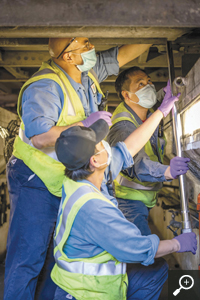 Mechanics at Portrero Electric Trolley Bus Facility, two-thirds members of San Francisco Local 6, take extra care to keep one another safe. |
|
FOR TWO DECADES, shop steward Tom Mohan has wired at least a thousand convention exhibitions in New York City's mammoth Javits Center. Food, flowers, travel, the famous car show. And now a hospital. Local 3 crews helped construct 2,000 rooms divided by wall panels that would have enclosed booths of beauty products, eyewear and restaurant supplies, among the canceled spring events. With the Army Corps of Engineers in charge, safety was handled with military precision. "If you were going to the hospital floor, there was only one way in," Mohan said. "You had to stop there and put on a gown, goggles, N95 mask and gloves. You would take it all off before exiting out the other side." Even with all the precautions, "it was still a little nerve-wracking," he said. "You were always afraid you might bring something home to your family." Setting up trade shows at the Javits can employ 70 electricians or more. In late May, with no events and the hospital cleared of patients, Mohan's shop was down to a small maintenance team. "Everything's been canceled through the summer," he said. "I'm extremely nervous for my brothers and sisters that got laid off." THE VIRUS erupted in Westchester County when cases to the south in New York were still in the single digits. It was the first week of March. Lou Sanchez, a business representative in Local 3's White Plains office and 20-year member, was interviewing political candidates looking for union endorsements when his wife called. "A teacher she shares a classroom with tested positive — same room, same computer," Sanchez said. "We quarantined at home for 14 days. Luckily no one got sick." But thousands of county residents rapidly did. On March 22, the Westchester County Center was one of four sites Gov. Andrew Cuomo designated for overflow hospitals, telling the Army Corps to forge ahead, "no red tape." The Javits and two Long Island sites were the others, all employing IBEW members. In just three weeks, Local 3 crews had helped construct 110 rooms from the studs up. "They knew it would be dangerous to put 100 guys there, so they broke it up into 12-hour shifts around the clock," Sanchez said. "Everyone had their N95 masks, gloves, there was Purell everywhere. They were given their own space to work. Everyone was really proud to be there" |
||
|
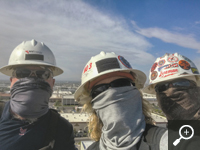 Local 396 President and NV Energy foreman Shannon Skinner, center, says she and her longtime crew are sticklers for rules to protect each other. |
|
MOST OF THE safety protocols developed by the city's building trades and signatory contractors have become mandates for construction sites statewide. They include rules for essential PPE, monitoring workers' temperatures, near-constant disinfection of surfaces, proximity to wash stations, and designating staircases as "up" or "down" but not both. And vital in a city of skyscrapers, elevator safety. "Vertical transportation has always been a challenge for the construction industry, just getting hundreds of workers up 60 floors," Erikson said. The waits for a ride are longer now, as workers keep their distance in the exterior lifts known as Alimaks. They face outside, their backs to each other. He knows some contractors will be more diligent than others but has faith in his members. "Electricians are smarter than the average bear," Erikson said. "I think they've got brains enough to know they've got to protect themselves and their families." He said nonunion employers pose the greatest threat of COVID-19 spreading on jobsites, knowing desperate low-wage workers won't report them for failing to enforce the new rules. But the building trades will. "We're going to be paying attention to those sites," Erikson said. "There's got to be compliance up and down the line. If there's not, that could end up shutting down the whole construction industry again." |
|
|
THE DAY that Sean McDonald first felt ill, New York City had logged just 137 cases of COVID-19. One week later, there were 5,683. In between, McDonald had gone from a nuisance cough to a brutal one; he had headaches, fever and eye pain. He lost his sense of taste. Minor exertion left him huffing and puffing. "Once or twice that week I was quarantining, my wife got called in to work at the hospital. I'd put a T-shirt over my face — we didn't have masks yet — and go downstairs and check on the kids. Just going up and down a flight of stairs, I'd be out of breath." On March 20, McDonald pulled into a drive-in testing site where a doctor pushed long swabs up his nose and checked his oxygen with a finger monitor. Alarmed, he sent him inside for a chest X-ray. "You need to go to the hospital," the radiologist told him. For hours he sat with a half-dozen others in an enclosed waiting room for likely COVID-19 patients. More filled the ER halls, where McDonald went in search of a nurse around 1 a.m. "Where am I supposed to pass out?" he asked her with as much good humor as he could muster. DOING THE GRIM work of electrifying a mobile morgue, Len Copicotto flashed on his time powering a hospital in the aftermath of Hurricane Maria in Puerto Rico. "We were doing something that was going to be helping a lot of people," he said. "Now we were pulling power from a hospital to something that symbolized how devastating this situation was going to get." Yet even in his own circle, there were still COVID-19 doubters. That day he let loose on social media. "I was feeling a sense of duty to reach out to friends and family who were still posting a lot of joke memes about the virus and were parroting a lot of cable news pundit shows that were saying it was the flu, it was a hoax, it was just alarmist paranoia," he said. He'd been on the front lines as Queens became "the center of the center of the hottest part of the outbreak." For weeks, he threw his clothes in the wash and showered as soon as he got home, where he slept in a spare room to protect his wife. Copicotto opted eventually to take one of the temporary furloughs offered, sheltering at a family cottage in Connecticut. He missed his union activities, including serving on the Local 3 election board. Its last meeting had been held in a nearly empty hall. "I told people, 'This will be the only time you'll ever hear me say this in my entire career: please do not go to the union meeting.'" WHILE SULLIVAN self-quarantined, she finished out the semester of the trade unionism classes she teaches at Empire State College in lower Manhattan. Her students are Local 3 apprentices, who are required to earn an associate degree in labor studies. Sullivan asked what they'd liked better: the virtual classroom or the real one. "Every one of them said they missed the in-class experience," she said. "I was surprised because it's so much easier to get on the computer in your shorts and T-shirt than it is to go all day to work and then get to class. But they missed the camaraderie of each other." They'd learned the biggest lesson of all: the power of solidarity. "I was so proud of them," she said. "They understood the importance of being with each other, how good solidarity feels, and how much you miss it when you don't have it." |
|
|
|
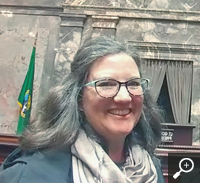 As Seattle dealt with the nation's first COVID-19 outbreak, Local 77's Christine Reid worried about keeping frontline workers safe. |
|
WESTCHESTER was making progress against COVID-19 as New York's cases skyrocketed. The world saw media reports of overwhelmed ERs, ICUs, and supply shortages that forced many nurses to reuse PPE that they'd normally discard between each patient. On a labor call, Sanchez learned that a charity in Yonkers that ships protective gear to impoverished countries had inventory, but not enough hands. "Usually they have retired nurses who volunteer, but all those retired nurses got called back to work," he said. That left PPE piling up in the Afya Foundation's warehouse while New York and other U.S. hotspots were in dire need. Sanchez delivered Local 3 volunteers to sort, count and pack gowns, surgical masks, gloves, booties and more. "We shipped out thousands of pieces of PPE to local hospitals," he said. AFTER TWO DAYS in a private room, McDonald was moved to the COVID ward when it was confirmed he'd tested positive. He was there nine days. A month later, he was working the night shift on a fast-tracked project adding a floor to a local hospital. The virus also struck his sister and their father, a retired Local 3 journeyman. All of them, now negative, have donated blood plasma to help other patients recover. They don't know who infected whom, or if they contracted the virus separately. "Taking the train, riding the subway, going to the deli, eating lunch outside with the guys. I could have gotten it anywhere," McDonald said. THE REPERCUSSIONS of COVID-19 will be felt for years, if not decades, to come. Some $63 billion worth of construction work may already be impacted in New York, Erikson said. Major subway and airport projects, among others, are up in the air. While safety is paramount, he sees the workplace debate around COVID-19 entering uneasy territory. "They're talking about having workers download apps onto their personal phones for tracking," he said. "We're concerned about that. There's no reason an employer should have the ability to track you when you're not at work. It's bad enough on a worksite." It's one of Erikson's many worries in an unchartered era. "We're still in a time when this whole thing is evolving," he said. "Where is it going to go? Where are we going to end up? We don't know what the post-COVID world is going to look like. |
|
|
© Copyright 2020 International Brotherhood of Electrical Workers | User
Agreement and Privacy Policy |
Rights and Permissions |